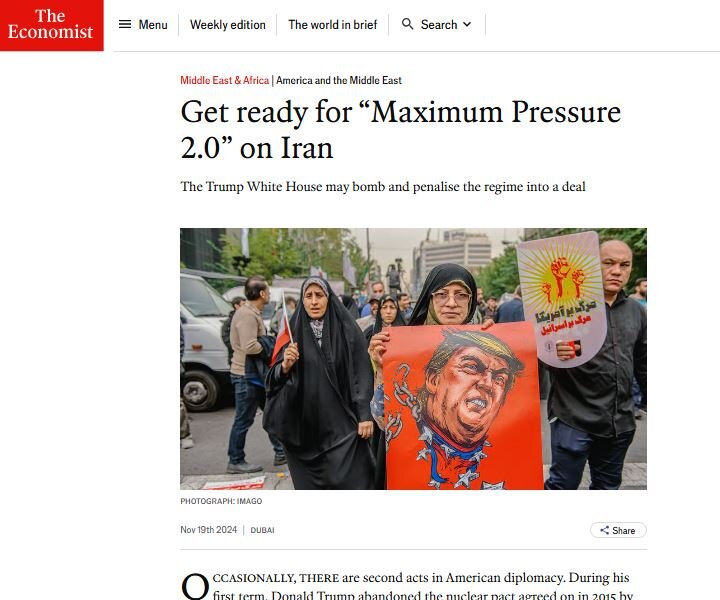U.S. ‘maximum pressure’ on Iran: road to repeated failure

TEHRAN – As the U.S. presidential inauguration approaches, speculation mounts regarding Donald Trump's approach to Washington's "adversaries."
Western think tanks and international relations scholars suggest Trump’s foreign policy may largely continue the trajectory of his first term.
An article in The Economist, titled “Get ready for Maximum Pressure 2.0 on Iran,” argues that the Trump White House may “bomb and penalize Iran into a deal”.
To assess whether a second Trump term would succeed with a continued “maximum pressure” campaign against Iran, we must first evaluate its effectiveness during his first term. A policy's success is measured by whether it changes the target's behavior—in this case, whether Iran curtailed its nuclear program and reduced support for Resistance groups.
The article overstates the impact of sanctions on the Iranian economy. While sanctions significantly affect Iran's economy, they haven't “crippled” daily life or achieved the "regime change" goal of maximum pressure.
Despite sanctions, support for terrorist groups and separatists, and incitement during protests, several peaceful protests that turned violent in recent years seemed to have had Western origins or at least received the West’s backing, the Iranian government remains firmly in power.
While the article correctly notes Iran's increased oil exports, it overlooks how Tehran circumvented sanctions. Initially, "maximum pressure" significantly reduced Iranian oil exports, but Tehran subsequently found ways to bypass them—similar to Russia's recent experience—by finding new buyers that were less reliant on Washington, offering discounts, and evading U.S. tracking.
Despite a change in administrations, Trump’s successor, Joe Biden, continued the sanctions policy, yet failed to bring Iran back to negotiations. Now, with U.S.-China tensions high, Washington's alleged approval of China's purchase of Iranian oil appears irreversible. The incoming administration lacks viable alternatives to offer China in exchange for Iranian oil on the global market. The Trump-era "trade wars" and confrontation with Beijing persist as a major issue as well.
Furthermore, the "maximum pressure" campaign's intended isolation has failed, as Iran has strengthened ties with the Global South. Membership in BRICS and the Shanghai Cooperation Organization provides Iran with alternative avenues to mitigate the impact of U.S. sanctions.
The author argues that Iran’s new president is in “desperate” need of a renewed nuclear deal in order for economic relief. However, in reality, the foreign policy in the country does not solely rely on the president. Masoud Pezeshkian and his administration play a significant role in decision making but other important figures and state bodies also have a say. There is also no evidence that Pezeshkian and his team are averse to policies previous administrations took against Washington and its European allies.
Another important point is that reversing Iran's nuclear advancements and returning enrichment levels to those stipulated in the JCPOA appears unrealistic. The JCPOA failed to fully dismantle Iran's nuclear capabilities, and further sanctions would likely only accelerate its nuclear program's potential militarization.
A recent IAEA resolution demands clarification by Iran about what the agency calls the possible presence or use of undeclared nuclear materials. Tehran has been cooperating with the IAEA since Trump unilaterally withdrew from the 2015 deal. After the resolution according to Iran’s parliament speaker, the country has begun operating advanced uranium enrichment centrifuges. Iran's rejection of a Western-sponsored censure motion at the IAEA underscores its intention to maintain its relationship with the UN nuclear watchdog.
A significant development since Trump's first term is the direct military exchange between Iran and Israel—a major escalation in the West Asia region since the Islamic revolution. Despite these actions, including Iranian retaliatory strikes following Israeli attacks on an Iranian embassy and the assassinations of key Resistance figures, Washington has only aided Israel in defense and largely stayed out of the scuffle. Tel Aviv has actively sought U.S. military intervention against Iran, particularly since the start of the Gaza war, but Washington appears to have enough on its plate because of the war in Ukraine and a possible escalation with China.
Though the possibility of the direct involvement of the U.S. in attacking Iran seems to be low, the idea of a green light to Israel to target Iranian nuclear sites has been circulating in scholarly circles. Despite the questionability of Israel’s capability to destroy Iranian sites, any attack on those sites will smash any justification for negotiations. Also, the know-how that Iran has acquired during the years will remain untouched. Any such operation may push Iran to the next level of escalation which may be targeting U.S. military sites directly in regional countries. This kind of crisis in the West Asia region will not only affect warring parties but also the global community in general.
